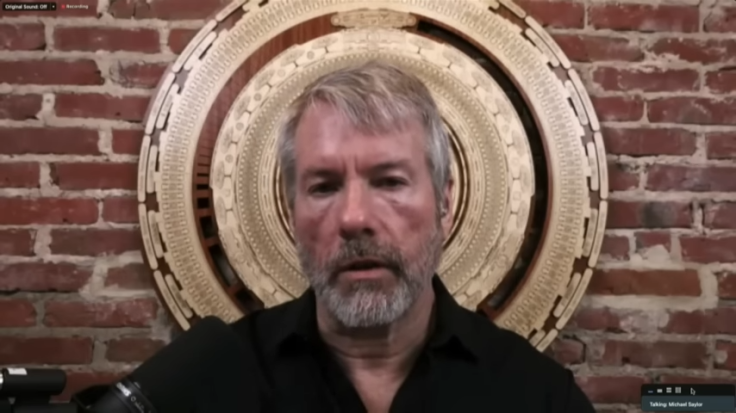MicroStrategy's Michael Saylor Reveals How Bitcoin Bet Helps MSTR Compete With Magnificent Seven

KEY POINTS
- Michael Saylor used to be skeptical about Bitcoin
- MicroStrategy started looking for a "high-growth digital monopoly" it could invest in and ended up with Bitcoin
- Saylor is now optimistic in the upcoming Bitcoin halving and spot BTC ETF launch in the U.S. that would decrease the crypto asset's supply
MicroStrategy's then-CEO Michael Saylor was skeptical about Bitcoin 10 years ago because of potential regulatory threats. However, the executive chairman of the American business intelligence and software company is now singing a different tune. He is even explaining how his huge bet on the world's oldest crypto asset has helped the company's stocks to compete with big tech juggernauts.
MicroStrategy Incorporated's (MSTR) stock reached a 52-week high price of $599.39 Sunday morning, underlining a 246% increase in 2023. While the current price is a far cry from the stock's all-time high price of $3,130 on March 10, 2000, Saylor shared how the company's bet on Bitcoin has helped MSTR compete with the big tech giants, particularly with the so-called Magnificent Seven, which pertains to the group of seven mega-cap growth stocks that include Apple, Microsoft, Alphabet, Amazon, Meta, Tesla and Nvidia.
Before MicroStrategy started investing in Bitcoin, there was government-induced inflation and a tech-driven deflation, which made it challenging for companies except the Magnificent Seven to see consistent and substantial growth.
"If you're a main street company, you're forced to fight for your survival with one hand tied behind your back. If you're going to keep up with the Magnificent Seven you're going to have to grow your revenues and cash flows at 20% a year or faster ad infinitum," Saylor said in a Fox Business interview last week.
I discuss how companies can escape the destructive cycle of the conventional corporate finance playbook, preserve their capital, keep up with the Magnificent Seven, and create shareholder value using a #Bitcoin Strategy similar to $MSTR, with @cvpayne. pic.twitter.com/apXEYbD46O
— Michael Saylor⚡️ (@saylor) November 6, 2023
"There's seven companies that generate all the shareholder returns. There's 7,000 companies that can't keep up. What we did in August of 2020 was recognize that there's no way we're going to outgrow Google and Microsoft and Apple Computer as a mid-sized software company," he added.
According to the executive, MicroStrategy started looking for a "high-growth digital monopoly" it could invest in and decided and at the time, Bitcoin seemed to be the most promising among assets.
"We realized Bitcoin is like a high-tech dominant digital network growing at 40% or 50% a year, and so we bought it," Saylor continued, before saying, "It's kept growing at 40% to 50% a year, and now we're using our balance sheet to grow the company."
The crypto asset has seen a sharp increase this year and can even rally to a much higher price with the possibility of spot Bitcoin ETF approval and the Bitcoin halving event happening in April 2024 — factors that make Saylor more optimistic about MicroStrategy's Bitcoin portfolio.
"[Bitcoin's] supply and demand are in [the] balance right now, but after the halving in April, the supply gets cut in half," Saylor explained. "And after the spot ETFs come online, the demand's going to at least double. So the only thing that's going to adjust there is the price in order to get the market to clear."
MicroStrategy's Bitcoin portfolio yielded significant returns, which began growing in August 2020 under the leadership of Saylor.
While Saylor and MicroStrategy faced heavy criticism in the past due to this investment, their commitment not only to invest in Bitcoin but also to hold onto it when the company faced losses has become an inspiration to many holders of the crypto asset.
MicroStrategy now holds 174,530 BTC acquired for approximately $5.28 billion at an average price of $30,252 per Bitcoin.
As of 11:40 a.m. ET on Sunday, Bitcoin was trading in the red zone at $43,950, which means the software and business intelligence company is now sitting on an unrealized profit of $2.390 billion.
© Copyright IBTimes 2025. All rights reserved.






















